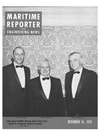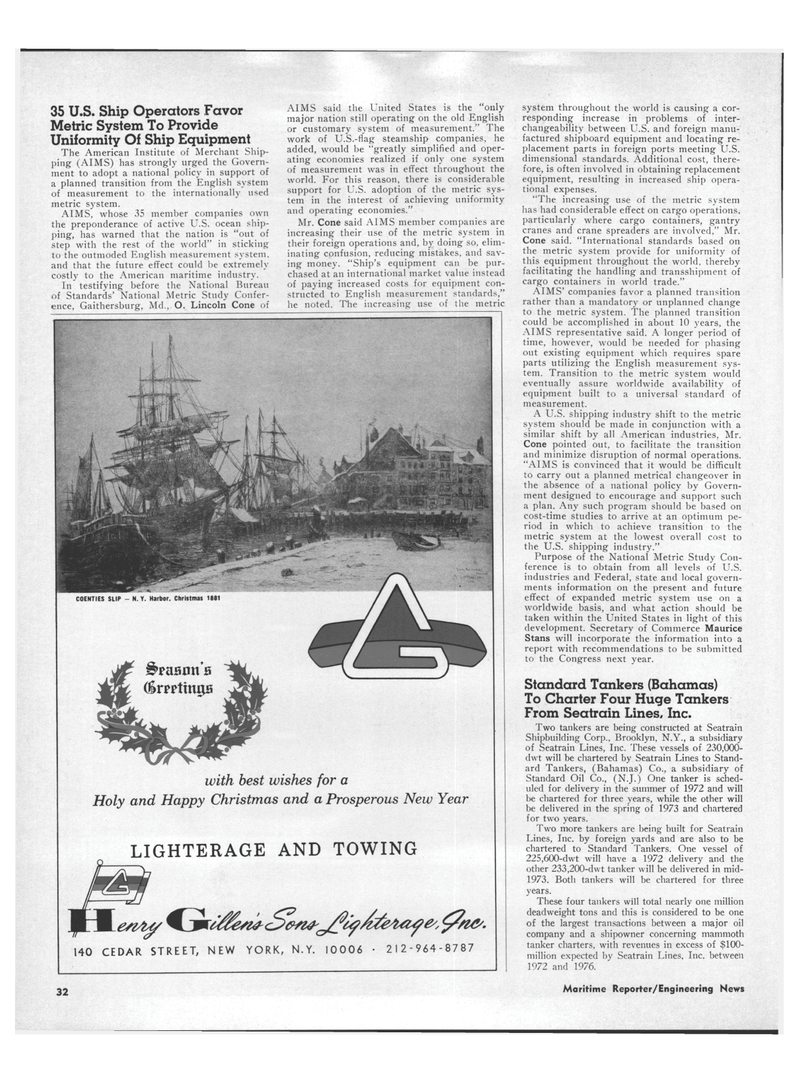
Page 30: of Maritime Reporter Magazine (December 15, 1970)
Read this page in Pdf, Flash or Html5 edition of December 15, 1970 Maritime Reporter Magazine
35 U.S. Ship Operators Favor
Metric System To Provide
Uniformity Of Ship Equipment
The American Institute of Merchant Ship- ping (AIMS) has strongly urged the Govern- ment to adopt a national policy in support of a planned transition from the English system of measurement to the internationally used metric system.
AIMS, whose 35 member companies own the preponderance of active U.S. ocean ship- ping, has warned that the nation is "out of step with the rest of the world" in sticking to the outmoded English measurement system, and that the future effect could be extremely costly to the American maritime industry.
In testifying before the National Bureau of Standards' National Metric Study Confer- ence, Gaithersburg, Md., O. Lincoln Cone of
AIMS said the United States is the "only major nation still operating on the old English or customary system of measurement." The work of U.S.-flag steamship companies, he added, would be "greatly simplified and oper- ating economies realized if only one system of measurement was in effect throughout the world. For this reason, there is considerable support for U.S. adoption of the metric sys- tem in the interest of achieving uniformity and operating economies."
Mr. Cone said AIMS member companies are increasing their use of the metric system in their foreign operations and, by doing so, elim- inating confusion, reducing mistakes, and sav- ing money. "Ship's equipment can be pur- chased at an international market value instead of paying increased costs for equipment con- structed to English measurement standards," he noted. The increasing use of the metric system throughout the world is causing a cor- responding increase in problems of inter- changeability between U.S. and foreign manu- factured shipboard equipment and locating re- placement parts in foreign ports meeting U.S. dimensional standards. Additional cost, there- fore, is often involved in obtaining replacement equipment, resulting in increased ship opera- tional expenses. "The increasing use of the metric system has had considerable effect on cargo operations, particularly where cargo containers, gantry cranes and crane spreaders are involved," Mr.
Cone said. "International standards based on the metric system provide for uniformity of this equipment throughout the world, thereby facilitating the handling and transshipment of cargo containers in world trade."
AIMS' companies favor a planned transition rather than a mandatory or unplanned change to the metric system. The planned transition could be accomplished in about 10 years, the
AIMS representative said. A longer period of time, however, would be needed for phasing out existing equipment which requires spare parts utilizing the English measurement sys- tem. Transition to the metric system would eventually assure worldwide availability of equipment built to a universal standard of measurement.
A U.S. shipping industry shift to the metric system should be made in conjunction with a similar shift by all American industries, Mr.
Cone pointed out, to facilitate the transition and minimize disruption of normal operations. "AIMS is convinced that it would be difficult to carry out a planned metrical changeover in the absence of a national policy by Govern- ment designed to encourage and support such a plan. Any such program should be based on cost-time studies to arrive at an optimum pe- riod in which to achieve transition to the metric system at the lowest overall cost to the U.S. shipping industry."
Purpose of the National Metric Study Con- ference is to obtain from all levels of U.S. industries and Federal, state and local govern- ments information on the present and future effect of expanded metric system use on a worldwide basis, and what action should be taken within the United States in light of this development. Secretary of Commerce Maurice
Stans will incorporate the information into a report with recommendations to be submitted to the Congress next year.
Standard Tankers (Bahamas)
To Charter Four Huge Tankers
From Seatrain Lines, Inc.
Two tankers are being constructed at Seatrain
Shipbuilding Corp., Brooklyn, N.Y., a subsidiary of Seatrain Lines, Inc. These vessels of 230,000- dwt will be chartered by Seatrain Lines to Stand- ard Tankers, (Bahamas) Co., a subsidiary of
Standard Oil Co., (N.J.) One tanker is sched- uled for delivery in the summer of 1972 and will be chartered for three years, while the other will be delivered in the spring of 1973 and chartered for two years.
Two more tankers are being built for Seatrain
Lines, Inc. by foreign yards and are also to be chartered to Standard Tankers. One vessel of 225,600-dwt will have a 1972 delivery and the other 233,200-dwt tanker will be delivered in mid- 1973. Both tankers will be chartered for three years.
These four tankers will total nearly one million deadweight tons and this is considered to be one of the largest transactions between a major oil company and a shipowner concerning mammoth tanker charters, with revenues in excess of $100- million expected by Seatrain Lines, Inc. between 1972 and 1976.
Mason's (Srpptinna with best wishes for a
Holy and Happy Christmas and a Prosperous New Year
LIGHTERAGE AND TOWING 140 CEDAR STREET, NEW YORK, N.Y. 10006 • 212-964-8787 32 Maritime Reporter/Engineering News

 29
29

 31
31
